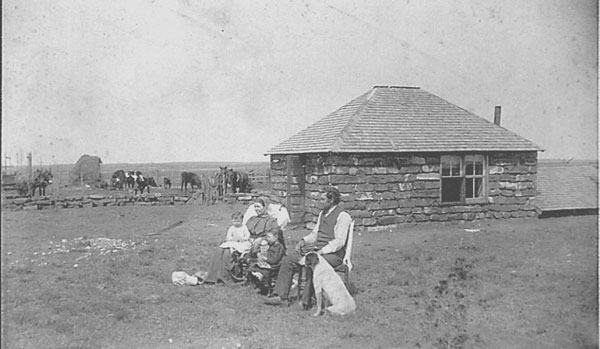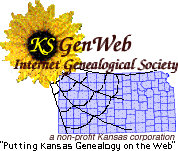Reno County KSGenWeb Project |
Reno County KSGenWeb Project |
The Following was recorded by Annie Elizabeth Bower Pitzer, date is unknown. Between 1960 and 1970,
typed, digitized and pictures added by Phillip H. Pitzer, May 2007. Submitted in Jun 0f 2020. For her
original writings, Click Here
 James Harrison Pitzer, born February 19, 1835, Lydia E. Bowman, was born February 24, 1837, they were married December 13, 1855 in the state of Virginia. There were few Bibles at that time. Someone in the community had a Bible. Neighbors came evenings to hear it read. Grandpa (James Harrison Pitzer) hung a lantern on his arm, rode his horse, grandmother (Lydia E. Bowman Pitzer) got up behind him and carried the baby in her arms and they went to the neighbors home to hear the Bible read to them. The country was hilly and roads poor, not many wagons, people went on their horses. When grandfather John Riley Pitzer (son of James Harrison and Lydia Bowman Pitzer) was two years old in 1871 James Harrison, Lydia and their family moved to Indiana. They went by train. Grandmother Lydia looked after the girls (In 1871 James and Lydia would have had five girls, Mary Frances, Martha Jane, Margaret Belle, Leah Anna, and Harriett Elizabeth). Grandfather took care of the boy John Riley. After he bought the tickets and looked after the baggage he could not find his boy and asked the ticket agent if he had seen a boy two years old around there. The agent said “that looks like him on your back”, and it was. When John Riley was thirteen (1882) the family moved to Texas for health of his father, James Harrison. James had a severe cough and the doctor advised him to go to Texas so he did, and he got well and strong and lived to be 84 years old. Died November 2, 1919. John Riley Pitzer, in 1891, went to McPherson, Kansas, to attend the Church of The Brethren, sponsored McPherson College. My parents, David Bower and Susannah Badger Bower moved to McPherson at about the same time as John came to McPherson and we started our education at the McPherson College at the same time. John's mother Lydia E., passed away while he was attending McPherson College and I heard about it. We were at the same table in the penmanship class and that was where we got acquainted. My mother Susannah, passed away in 1893 and John and I were married in May 23, 1894. Neither of us had graduated, I helped take care of my mother during her sickness and did not go to school afterwards. After living on my folks farm in Barton County, KS for three years, we moved, in 1897, to Washita County, Oklahoma. Our oldest daughter, Alice was two and one half years old. We travel in a covered wagon. I drove the ponies, Dandy and Squirrel hitched to the spring wagon; it had a crate of chickens, a box with two small chester white little pigs and some other things. My feet rested on top of the dashboard so Alice rode in the wagon with with her daddy and sit on the bed and strung buttons for her past time on the way. John had Queen and Molly hitched to the heavy loaded wagon he drove. There were no bridges on the rivers. We forded the North and South Canadian rivers and the Salt fork and Washita rivers. I would not drive my team across the rivers. John would drive his team across, then unhitch his team and ride one horse back to drive scross with me. Sometimes he used four horses to take his wagon across where the rivers was deep. We homesteaded in Washita County in Cheyenne Indian country, in September 1897. Johns sister Maggie and Frannie lived near by. Our claim joined Maggie and George Rogers claim. George Rogers helped John make us a dugout where we lived the first winter then John hauled native rock and Uncle George built us a stone house, twelve by sixteen feet, with a lean to kitchen on the side. It was of lumber.  Jame Paul Pitzer was born the next year and the girls Gladys Esther and Anna Marie were born in that little house. Paul was three when he was in the field with his daddy who was plowing and Paul was waiting at the end of the field and was bitten by a rattlesnake. His leg got spotted and swelled. John took him to our neighbor, Mr. Craig who had snake medicine and he got over it. We made a milk house with the sandstone same as our home and had a windmill over the well near the house. All the water for the stock went threw the milk house to the stock tank; a milk tank in the milk house was where we had two gallon stone jars in water to keep the milk cool. Paul's dog Bounce churned for us on a treadmill outside the milk house. He was tied on a platform made by setting a post in the ground and putting a big wheel on the post on a 45 degree angle. A floor on one side of the wheel had slats nailed on and there was a fence around the floor. The churn was an 8 gallon barrel churn in the milk house connected by a rod threw the milk house. Gladys Esther was when she climbed upon the windmill tower and called to me, come up and see she said ”I can see where Aunt Maggie and Uncle George live and all around”. She was dancing first on one foot and then the other. I was so scared she would fall. I could not go up to get her. It was in the fall before Minnie Maye was born in December. I talked to her and coaxed her down. Her father took the lower rounds off that ladder when he came home so she did not try that again. Anna Marie was two years old when she gave us a scare. John had came home from the gin where he had sold the bale of cotton late on Saturday night. We were all asleep so he lay down on the divan and put his pocket book under his pillow. Next morning John had to leave early to drive 10 miles to his appointment to preach and did not think of his pocket book. When he got home he looked for it. It was not there and none of us had seen it. We thought it was gone and one half of the price of the bale of cotton had to go for the picking. It was 2 or 3 weeks later Paul was digging in the yard where the children played and dug up that pocket book where Marie had buried it. We felt happy it was found. One day the horses got out of the pasture and came up the road and in the driveway. John was there to open the gate to help get them into the lot. Marie was out there and to small to get away, was not afraid. One of the colts in play ran close to her, kicked up his heels over her head. John saw the colt and shut his eyes. He expected the colt would hit Marie but he had kicked up over her head, did not touch her. That first year we lived in the dugout an Indian came to our home and John was not there. He could speak our language and asked where my husband was and I told him and he went to Uncle Georges home where John was helping with some work. The White men had been stealing wood from the Indians. White settlers would go at night to the creek and chop down trees and haul them home for firewood. The Indians owned all the land where the creek was. All the trees were on the creeks. But we never stole from the Indians. John bought a ridgepole for our dugout from the Indians. We burned “Cow chips” and some coal. Fuel was scarce. Our nearest railroad was at El Reno, Oklahoma, 75 miles from Cordell, Oklahoma. We lived there several years before we had a railroad into Cordell, Oklahoma. There were no rural telephones and no rural mail routes and no automobiles. The 160 acres we homesteaded was prairie, not a furrow turned or a post set, not even a road past our place before we got there. Minnie Maye is the youngest child. When she was 6 months old we went to Texas to visit grandpa and grandma Pitzer in a covered wagon and when grandpa found out we had not named our baby girl, he named her for us. Our first car was a model T Ford in 1916 and we went to Texas again and got up to a speed of 20 mph. I said when we get home I'll stay there if you are going to drive so fast, Ha! I was born in Stephenson County, Illinois on April 2, 1872 and lived there until the early spring of 1883. We moved to Dallas County, Iowa (where all of my mothers people lived) on a farm that joined my grandparents home. Early in the year of 1885 we moved to Barton County, Kansas where I grew up. There were 5 girls of us and we helped our father to farm as it was wheat country, he farmed big fields of wheat. He had ˝ section of land and an 80 acre piece of hay land, and we milked a good many cows. In October 1891 my family and I moved to McPherson, Kansas where we could attend our Church College and I met the young man who became my life companion, John Riley Pitzer. John grew up in Texas, and came to McPherson at the same time I did. I was 19 and John was 22. We were raised on farms and did not know all the smart ways that young folks now know. I had never heard of keeping step in walking. John lived at the College three years. He went to school a half a day and farmed for the College a half a day and that is the way he got his education. He milked the cows and done the College chores besides farm work for three years. We sat at the same table in the penmanship class, that is where we got acquainted. His mother passed away and he was needing a friend I thought. When he and the business managers wife, Mrs Peck came for shrubbery for the College lawn I helped my mother to entertain them and our friendship started by the lilac bush in our front yard. We were married in May 23, 1894. My mother had passed away and my schooldays were over. Neither of us had graduated. We moved to a farm in Barton County, Kansas, where Alice Ruth was born March 5, 1895. In 1897 we went to Oklahoma to visit Johns sisters. Alice was 2 years old. In the James Harrison Pitzer family there were two sons and seven daughters. The first two daughters named Mary Frances and Martha Jane were quite young when they had diphtheria and passed away, both within a few days of each other. Then they had three more girls Margaret Belle, Leah Anna, Harriett Elizabeth and then John Riley, then two more girls, Francis “Fannie” Lydia, Sarah Adeline, and then oah Coleman. (Note there was a son between Frances and Sarah, James Willie, who lived only one year.) John was almost grown when he had a little brother. With so many sisters and he was the only boy, you may be sure he received plenty of attention. One Christmas the girls each got a doll and John got a knife. He did not say a word, but went to the door and threw his knife as far as he could. He wanted a doll too. When John was leaving home to go to McPherson College he hung his hat on a nail in his mothers room. She was an invalid. He knew he would never see her again, but she told him to go on to school. She never allowed anyone to take away that hat from its place on the wall where she could see it. The following words were on back of page 1  |
Return to Pitzer Index Return to RenoCoKS Main Page
 |
Copyright 2010 - present by the KSGenWeb Team. All rights reserved. Copyright of submitted items belongs to those responsible for their authorship or creation unless otherwise assigned. |
 |